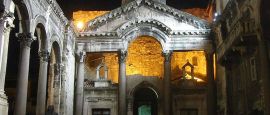This modest sand beach and concrete bathing area overlooking the shallow waters of Bačvice Bay is busy almost all year round. A number of busy waterside cafés and bars offer outdoor seating with a sea view. Popular with bathers by day, the beach also comes into its own at night when the bars and clubs kick off.
Things to see in Split
Tourist offices
Address: Peristil bb, Split, 21000, Croatia
Tel: +385 21 348 600.
Opening Hours:Mon-Sat 0800-2100, Sun 0800-2000. www.visitsplit.com
Maps, itineraries and general information on accommodation, transport and tours in the city are all available from the Split Tourist Information Centre.
The Splitcard (www.visitsplit.com) offers discounts in various museums, restaurants and hotels, and with some car hire companies and travel agents. It is available from tourist offices and hotels and is valid for three days.
Located inside 17th century Gripe Fortress, the museum contains a range of different artefacts from various periods, including the oldest torpedoes in the world, a collection of anchors from ancient shipwrecks, nautical equipment and model ships from ancient galleys to modern cruise liners. It also tells the story of Adriatic fishing traditions.
Designed as a retirement home for Emperor Diocletian in AD295, this vast complex is based on a rectangular plan measuring 215m (705ft) by 180m (590ft) and has four outer walls. The main public space is still intact, though much of the palace is now a labyrinth of stone buildings and paved alleys added from the 14th century onwards.
Linked to Diocletian's Palace by the Zeljezna Vrata (Iron Gate), this pedestrian-only space has been Split's main square since the 14th century. Locals refer to this elegant space, which is paved with white marble and fringed by open-air cafés, as Pjaca (from the Italian, piazza). The centrepiece is the 15th-century town hall with three Venetian-gothic arches.
The Old Town branch of Split's Ethnographic Museum offers a chance to explore one of the historic houses at the heart of Diocletian's Palace. The medieval rooms have been painstakingly reconstructed and the galleries showcase a range of artefacts from bygone eras.
On Peristil, the core of the cathedral is a 3rd-century octagonal mausoleum, built for Diocletian. It became a church in the 7th century, when refugees from nearby Salona dedicated it to their former bishop. Climb the majestic 60m-high (197ft) bell tower for a bird's eye view of the palace.
Established in 1893, making it one of the oldest museums in the country, this museum contains 150,000 artefacts, stone imprints, glass and ceramics originating from various historical periods. There are also examples of jewellery, weaponry and objects of everyday use, as well as a large number of stone monuments from early Croatian churches.
Possibly Split’s most bizarre attraction, but a hit with visiting tourists nonetheless, Froggyland is an eccentric collection of 507 stuffed frogs, all arranged in different day-to-day situations. Kids in particular will adore the frog-focused recreations of a blacksmiths, carpentry shop, school, circus and tailors.
Designed in the 1930s by Ivan Meštrović, Croatia's greatest 20th-century sculptor, this villa and its garden display a vast collection of his works in wood, marble, stone and bronze. The entrance ticket is also valid for Kaštelet (at no 39), where some of his bas-relief woodcarvings are on show in the chapel.
This 3.5km-long (2 miles) peninsula, rising west of the Old Town, is planted with pines and Mediterranean shrubs, and criss-crossed by a network of footpaths. The best sea views can be enjoyed from the southern slopes, following the path from Vidilica Café (above Varoš) to Bene recreation ground (on the tip of the peninsula).
Do you have any Feedback about this page?
© 2025 Columbus Travel Media Ltd. All rights reserved. No part of this site may be reproduced without our written permission, click here for information on Columbus Content Solutions.








 You know where
You know where